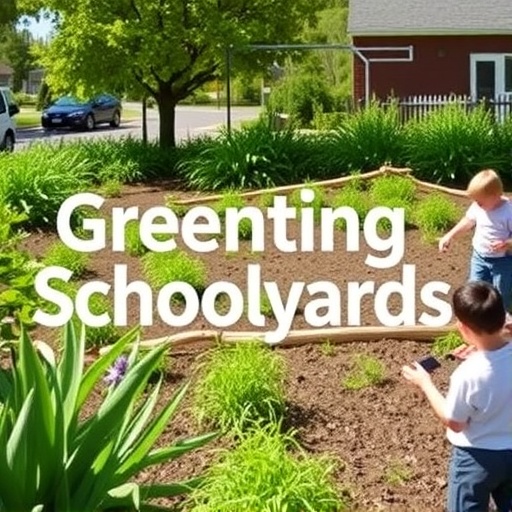In an era marked by rapid urbanization and increasing disconnection from the natural environment, a transformative movement is quietly reshaping how communities interact with green spaces. Recent research spearheaded by Blanc, Clauzel, About, and their colleagues explores the greening of schoolyards as a pioneering example of nature-based solutions aimed at bridging the gap between people and nature. This initiative, detailed in the upcoming 2025 edition of npj Urban Sustainability, offers groundbreaking insights into the multifaceted benefits of integrating natural elements within urban educational settings, ultimately proposing a blueprint for sustainable city living.
As cities expand and concrete dominates the landscape, the psychological and ecological costs of limited access to natural environments have become glaringly apparent. The study emphasizes schoolyards as ideal arenas for reversing this trend, not only fostering environmental stewardship among the younger generation but also improving urban biodiversity. By converting traditionally barren play areas into vibrant ecosystems, schools can catalyze community-wide engagement with nature, enhancing well-being and ecological literacy simultaneously.
Central to the research is the concept of nature-based solutions (NBS), which leverages natural processes and green infrastructure to address societal challenges. Schoolyard greening exemplifies NBS by replacing impervious surfaces with permeable soil and vegetation, thereby mitigating urban heat islands and managing stormwater more effectively. These interventions are not merely aesthetic; they represent scientifically robust techniques to enhance resilience against climate change impacts while promoting sustainable urban development.
The technical implementation of these greening projects involves meticulous planning and ecological design principles. The authors outline methods such as soil remediation, native plant selection, and creation of microhabitats that support pollinator species. This approach ensures that schoolyards evolve into multifunctional landscapes that serve educational, ecological, and social purposes. Engineering decisions focus on maximizing water retention and soil health, which in turn supports plant vitality and biodiversity.
From a pedagogical perspective, the study highlights how green schoolyards act as living laboratories. Through direct interaction with flora and fauna, students develop not only knowledge but a tangible emotional connection to the environment. This experiential learning aligns with emerging educational paradigms that emphasize hands-on engagement and intergenerational transmission of ecological values, crucial for fostering future environmental leaders.
Furthermore, the research delves into the social dynamics influenced by these green spaces. It demonstrates how greening initiatives encourage inclusive community participation, bridging socioeconomic divides that often limit access to quality green areas. In turn, this inclusivity boosts social cohesion and collective responsibility for urban environmental stewardship, key components in the success of sustainable urban ecosystems.
Ecologically, the transformation of schoolyards yields significant benefits beyond human interaction. Increased vegetative cover enhances carbon sequestration capabilities, contributing to urban climate mitigation efforts. The restored habitats support native wildlife, which often suffers under urban pressure, thus improving local biodiversity metrics and ecological network connectivity within the urban matrix.
Technology complements these natural processes through the integration of sensors and smart irrigation systems, optimizing water usage and monitoring environmental conditions in real-time. The authors advocate for the use of data-driven management to maintain ecosystem services effectively, stressing that blending technological innovation with natural elements offers a resilient and adaptive framework for urban green infrastructure.
Policy implications are profound. The study argues for systematic incorporation of schoolyard greening within municipal urban planning and educational policies. By embedding these nature-based solutions into public infrastructure standards and funding mechanisms, cities can scale the benefits observed in pilot programs to city-wide implementations, advancing sustainable development goals.
Importantly, the psychological impacts on students and staff are quantified through physiological and behavioral assessments. The presence of nature correlates with reduced stress levels, improved attention spans, and enhanced emotional well-being. Over time, these mental health benefits accumulate, underscoring nature’s critical role in promoting holistic health amidst the pressures of modern urban life.
Urban resilience also stands to gain significantly from widespread schoolyard greening. During extreme weather events, vegetated schoolyards absorb excess rainwater, reducing flood risks in nearby neighborhoods. Moreover, the cooling effects of increased tree canopy coverage mitigate heat stress during summer months, which is particularly vital for vulnerable urban populations.
The study addresses challenges and limitations candidly. Maintenance demands, budget constraints, and community engagement hurdles require proactive strategies, including partnerships with local organizations, training programs, and dedicated funding streams. By acknowledging these realities, the research offers practical guidelines for overcoming barriers that often stall green infrastructure projects.
In terms of scalability, the authors envision a networked approach wherein schoolyards connect with other urban green spaces to form ecological corridors, enhancing functional connectivity across cities. Such integration not only benefits biodiversity but also provides seamless green pathways for residents, enriching urban life quality on a broader scale.
Ultimately, the greening of schoolyards represents a paradigm shift—a transition towards cities that nurture their inhabitants and the natural world simultaneously. This initiative exemplifies how small-scale, community-centric interventions can drive systemic change, aligning urban living with ecological realities and human health imperatives.
The study by Blanc and colleagues thus shines a spotlight on a transformative, actionable strategy for urban sustainability. By reconnecting people, especially children, with nature through thoughtfully designed green schoolyards, cities can cultivate resilient, vibrant ecosystems that support ecological balance and human flourishing well into the future.
Subject of Research:
Greening of schoolyards as a nature-based solution to enhance connection between people and nature within urban environments.
Article Title:
Schoolyards greening for connecting people and nature: an example of nature-based solutions?.
Article References:
Blanc, N., Clauzel, C., About, C. et al. Schoolyards greening for connecting people and nature: an example of nature-based solutions?. npj Urban Sustain 5, 64 (2025). https://doi.org/10.1038/s42949-025-00252-6
Image Credits: AI Generated




